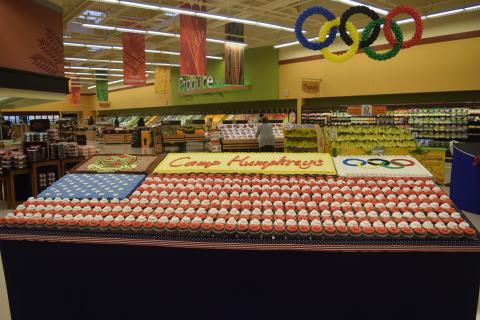CAKE LOVE: Whatever the event, this dessert has proven its tasty worth throughout U.S. military history

FORT LEE, Va. – After a good meal, the crowning moment everybody waits for is the end – the serving of the dessert. And what is more decadent than a slice of tempting cake? Did you know that George Washington’s favorite cake was carrot cake?
During the holidays, military customers can visit their commissaries’ bakeries to indulge their craving for cakes at significant savings.
For military members such as Marine Sgt. Maj. Michael R. Saucedo, senior enlisted advisor to the DeCA director, cakes are part of celebrating big events.
“It is common for many people to celebrate special occasions, birthdays, anniversaries, graduation, with cake,” Saucedo said. “My favorite occasion to eat cake is the Marine Corps birthday.”
So how did cake achieve its status as the go-to dessert?
In ancient Mesopotamia cakes were baked using honey, figs, nuts, dates and spices and offered to the gods and goddesses in special ceremonies. The ancient Greeks and Romans created beautiful cakes decorated with flowers, fruit and nuts and sweetened with honey.
Some of the best ancient Roman chefs made sweet cakes flavored with blackcurrants and cheese cakes baked with flour, honey, eggs, ricotta cheese and poppy seeds. They also baked wine cakes using reduced red wines, cinnamon and honey.
Cake also has a history with the U.S. military. During the American Civil War, sugar was difficult to acquire and so cakes had to be baked using substitutes such as molasses, honey, dried fruit and spices. Some women from local churches baked molasses cakes and gave them to the troops. They were easy to store and transport and provided the men with a taste of home.
During the First World War, sugar was being rationed and the troops ate something called “trench cake” because it was literally eaten in the trenches. The recipe called for spices such as nutmeg, ginger and cinnamon as well as molasses. But, it didn’t contain any eggs. It was dry but it lasted a good while and could be transported easily.
When World War II rolled around, sugar became the first food item to be rationed. Just as in World War I, cakes were baked using no sugar or eggs. Molasses, cloves, cinnamon, raisins and other dried fruit were substituted. They were certainly much drier than cakes are today, but cooks had to make do.
At the beginning of the Korean War ration kits began including a dessert entrée which usually consisted of some sort of cake. The most popular were pound cake, fruit cake and pecan cake rolls. The entrées were packaged in OD green cans and included with C ration kits. Military mess halls served frosted sheet cakes at meal times, as well.
Modern day Meals Ready to Eat (MREs) contain quite a number of dessert entrées that include cake. Some of the most popular MRE cakes are poppy seed, lemon pound cake and applesauce cake. And be sure to take a look at this month’s “Minute of History” on cakes.
-DeCA-
PHOTO CAPTION: Cakes, like this combination of cupcakes and regular cakes at the Camp Humphreys grand opening in 2018, are a staple of big events. (DeCA photo)
About DeCA: The Defense Commissary Agency operates a worldwide chain of commissaries providing groceries to military personnel, retirees and their families in a safe and secure shopping environment. Commissaries provide a military benefit, saving authorized patrons thousands of dollars annually on their purchases compared to similar products at commercial retailers. The discounted prices include a 5-percent surcharge, which covers the costs of building new commissaries and modernizing existing ones. A core military family support element, and a valued part of military pay and benefits, commissaries contribute to family readiness, enhance the quality of life for America’s military and their families, and help recruit and retain the best and brightest men and women to serve their country.
